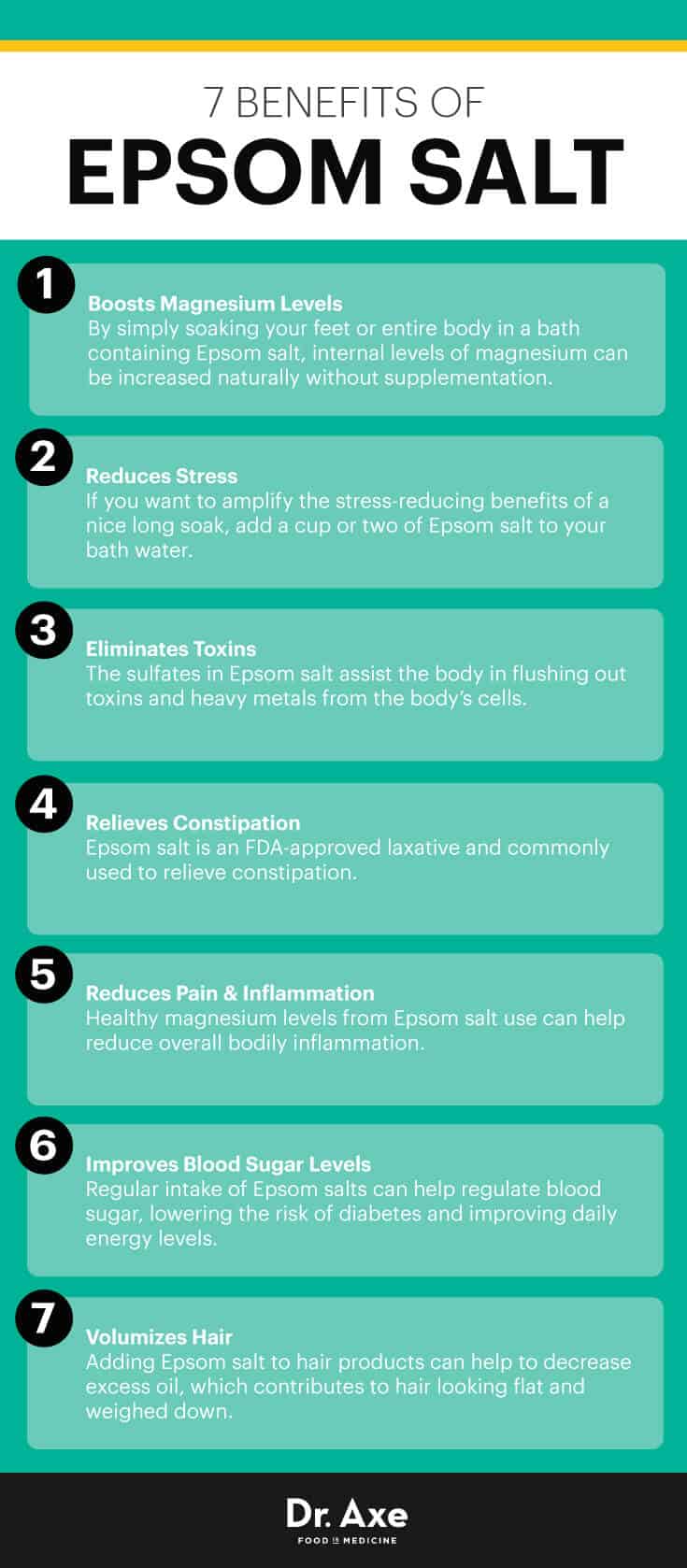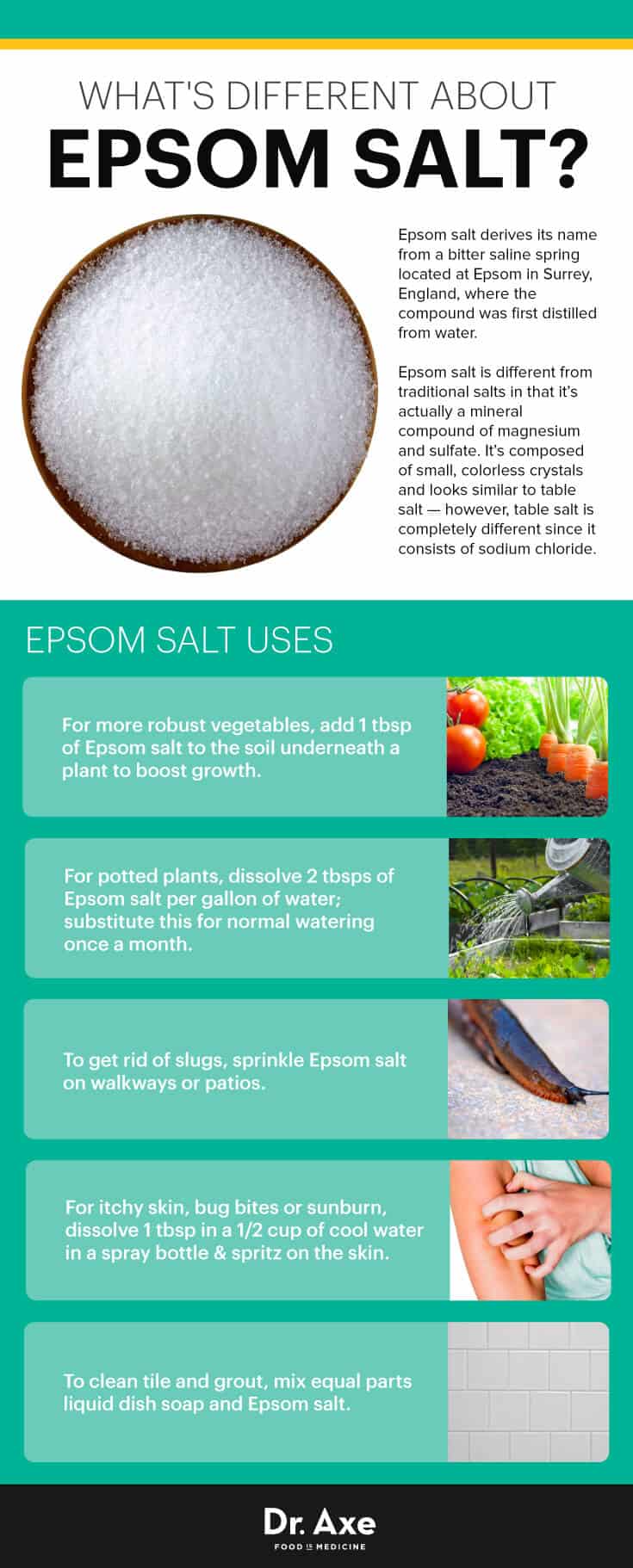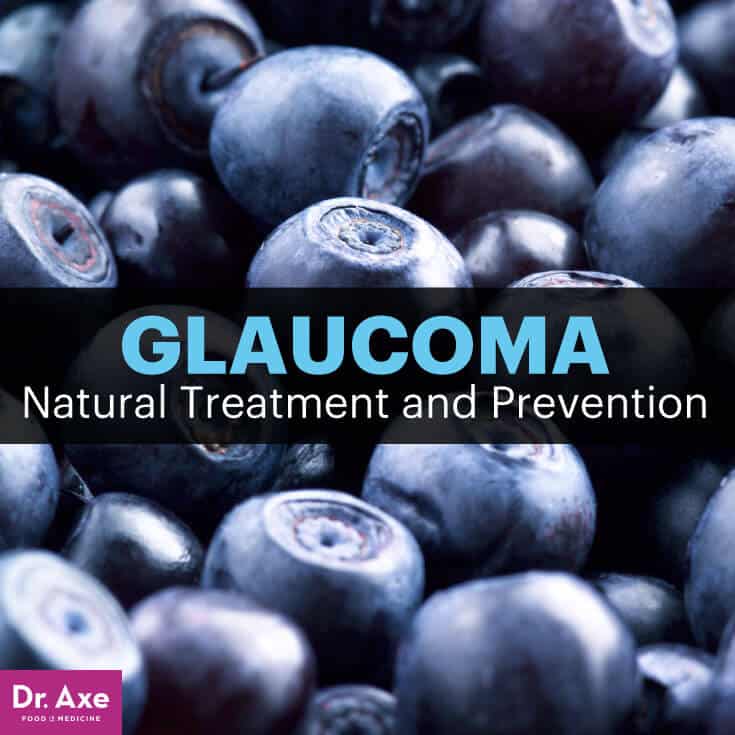Epsom Salt — The Magnesium-Rich, Detoxifying Pain Reliever

Athletes commonly use it for sore
muscles while gardeners sprinkle it on plants to increase their growth.
Epsom salt has a long history of diversified use and benefits for
health, beauty, household cleaning and outdoor gardening. It was
originally prepared from mineral water while today it’s obtained mainly
from mining operations.
Epsom salt is a natural exfoliant and anti-inflammatory remedy that can be used to treat muscle aches and sore muscles, dry skin, and even to fight various internal health issues. Simply add Epsom salt to your next detox bath recipe or foot soak to create a luxurious and therapeutic at-home spa experience.
Epsom salt derives its name from a bitter
saline spring located at Epsom in Surrey, England, where the compound
was first distilled from water. It’s different from traditional salts in
that it is actually a mineral compound of magnesium and sulfate.
The chemical formula for magnesium sulfate is MgSO4, which shows that Epsom salt can actually be broken down into magnesium, sulfur and oxygen. Epsom
salt is composed of small, colorless crystals and does look similar to
table salt — however, table salt is completely different from Epsom salt
since it consists of sodium chloride.
7 Benefits of Epsom Salt
There is a laundry list of ways to use Epsom salt in your daily life. Here are some of the top benefits of Epsom salt:
1. Boosts Magnesium Levels
Appropriate levels of magnesium are absolutely key to good health, and it is very common to have a magnesium deficiency.
Known as hypomagnesemia, low magnesium levels can be caused by
alcoholism, severe diarrhea, malnutrition or high calcium levels (hypercalcemia).
By simply soaking your feet or entire body in a bath containing Epsom
salt, internal levels of magnesium can be increased naturally without
taking magnesium supplements.
Magnesium regulates over 300 enzymes in the body
and plays an important role in organizing many bodily functions,
including muscle control, energy production, electrical impulses and the
elimination of harmful toxins. Magnesium deficiencies contribute to
today’s high rates of heart disease, stroke, arthritis, osteoporosis, chronic fatigue syndrome, digestive disorders as well as mental illness. By
boosting your internal magnesium levels through external use of Epsom
salt, you can help improve or ward off many avoidable health ailments.
2. Reduces Stress
Everyone has heard of the recommendation
to have a good soak in a warm bath after a rough day (whether mentally
or physically rough) — it’s a great way to bust stress. If
you want to amplify the stress-reducing benefits of a nice, long soak,
then add a cup or two of Epsom salt to your bathwater. Not only will the
magnesium in the Epsom salt help to relax your muscles, it can also
help to relax your mind.
According to research from the University of North Carolina, magnesium deficiency enhances stress reactions. Further studies show that magnesium has a profound effect on stress and neural excitability
— and magnesium salts such as Epsom salt can reduce stress and improve
neuropsychiatric disorders. Magnesium is critical to the production of
energy in cells so, by increasing magnesium levels, you can feel revived
without feeling restless (as opposed to how people feel revived from
caffeine consumption).
3. Eliminates Toxins
The sulfates in Epsom salt assist the body in flushing out toxins and providing a heavy metal detox from
the body’s cells, hence lowering the internal accumulation of harmful
substances. Human skin is a highly porous membrane; by adding minerals
like magnesium and sulfate to your bathwater, it sparks a process called
reverse osmosis, which literally pulls salt out of your body and
dangerous toxins along with it.
For a detoxing bath,
add at least two cups of Epsom salt to bathwater and soak for 40
minutes total. The first 20 minutes will give your body time to remove
toxins from your system while the last 20 minutes will allow you to
absorb the minerals in the water and help you emerge from the bath
feeling rejuvenated. Make sure to consume water before, during and after
the bath to protect yourself from dehydration and increase detoxification.

4. Relieves Constipation
Epsom salt is an FDA-approved laxative and is commonly used to naturally relieve constipation.
When taken internally, Epsom salt acts like a laxative by increasing
water in the intestines and cleansing the colon of waste. A roundup of
studies published in Therapeutic Advances in Gastroenterology notes that there is strong evidence that Epsom salt “has potent laxative effect in vitro through the release of digestive hormones and neurotransmitters.”
Internal use of Epsom salt can bring
about temporary relief from constipation, but like any laxative, it is
not meant to be a long-term solution or a substitute for a healthy high-fiber diet.
If a laxative solution is a must, it’s
smart to avoid many of the harsh laxatives on the market today, which
are commonly loaded with artificial colors and flavors and questionable
chemicals. To take magnesium sulfate orally,
it’s typically suggested to dissolve one dose in eight ounces of water.
Stir this mixture and drink all of it right away. You may add a small
amount of lemon juice to improve the taste.
Make sure to drink plenty of liquids
while consuming Epsom salt to prevent dehydration. Magnesium sulfate
taken orally should produce a bowel movement within 30 minutes to six
hours.
5. Reduces Pain & Inflammation
A warm bath containing Epsom salt is known to ease pain and relieve the inflammation at the root of most diseases, making it a beneficial natural treatment for bronchial asthma, sore muscles and headaches (including migraines). Epsom salt can also help heal cuts and reduce the swelling that accompanies sprains and bruises.
Have an annoying and painful splinter
stuck in your hand? Soak the problem area in warm water and Epsom salt,
and the splinter should be drawn out of the skin in no time! Soreness
after childbirth? Epsom salt can help with that, too. In general, healthy magnesium levels from Epsom salt use can help overall bodily inflammation since low magnesium has been linked with higher C-reactive protein (CRP), a marker of inflammation in the body.
6. Improves Blood Sugar Levels
Healthy magnesium levels have been linked with a reduced risk of developing diabetes. Epsom salt is an excellent source of magnesium.
Both magnesium and sulfate help improve the body’s ability to produce
and utilize insulin. Regular intake of Epsom salts, either orally or
transdermally, can help to regulate blood sugar, lowering the risk of
diabetes and improving daily energy levels. Studies continue to show how
a healthy intake of magnesium is associated with a lower risk of the development of type 2 diabetes in both men and women, proving Epsom salts work as natural diabetes remedies.
7. Volumizes Hair
Adding Epsom salt to hair products can help decrease excess oil,
which contributes to hair looking flat and weighed down. One easy way
to create your own volumizing conditioner at home is to combine equal
parts Epsom salt and conditioner (example: two tablespoons conditioner +
two tablespoons Epsom salt). After shampooing hair as usual, apply the
volumizing conditioner mix to hair, coating it from the scalp to the
ends. Leave the mix in for 1o to 20 minutes before rinsing. This is a great weekly hair treatment.
Epsom Salt History & Interesting Facts
The magnesium contained in Epsom salt is a
mineral that is crucial to the human body’s functioning. Some of the
key roles of magnesium include keeping blood pressure normal, heart rhythm steady and bones strong.
Sulfate is an essential mineral key to many biological processes, helping flush toxins; cleanse the liver; and assisting in the formation of proteins in joints, brain tissue and mucin proteins. Recent studies have shown that Epsom salt (magnesium sulfate) can even be used intravenously for the treatment of asthma and pre-eclampsia (pregnancy induced hypertension) in pregnant women.
Unlike other salts, external contact with
Epsom salt does not leave the skin feeling dry, but actually leaves the
skin feeling soft and silky.
Today, many people are aware of how prevalent vitamin D deficiency
has become, but the prevalence of magnesium deficiency is less
well-known. Most likely, the increase in magnesium deficiencies stems
largely from the increased consumption of processed foods in our diets. Studies
have shown that most Americans consume magnesium at levels below the
recommended daily allowance. Research from the Medical University of
South Carolina found that 68 percent of U.S. adults consume less than the RDA of magnesium and 19 percent consume less than half of the RDA.
Epsom Salt — Where to Find It and How to Use
Epsom salt can pretty much be found at
any drugstore and is very affordable. One- to two-pound bags are
typically in stock, but smaller sizes are available as well. You can
usually find Epsom salt where you find peroxide and rubbing alcohol or
in the laxative section. Once you have your Epsom salt at home, store it
at room temperature away from moisture and heat (this prevents it from
becoming compacted).
When it comes to external use of Epsom
salt for health reasons, the most common recommendation is to soak the
entire body in warm water containing one to two cups of Epsom salt for
at least 20 minutes. A half-cup of Epsom salt can also be added to a large pan of warm water for a 20-minute foot bath.
For internal use of Epsom salt, follow the guidelines on the packaging or consult your physician.
Epsom salt has a long history of use in
the garden as well. For more robust vegetables, you can try adding a
tablespoon of Epsom salt to the soil underneath a plant to boost
growth. Epsom salt is also great for indoor
gardening. For potted plants, simply dissolve two tablespoons of Epsom
salt per gallon of water, and substitute this solution for normal
watering once a month.
Looking to get rid of slugs from your walkways and patios without using chemicals? Sprinkle some Epsom salt to keep them away! For itchy skin, bug bites or sunburn, you can dissolve a tablespoon of Epsom salt in a half cup of cool water in a spray bottle and spritz on skin as needed.
Epsom salt can also be used for household
cleaning. To clean tile and grout, mix equal parts of liquid dish soap
and Epsom salt and apply this mixture to dirty and/or stained surfaces
anywhere in your home. Allow the mixture to soak in for a couple of
minutes, scrub away the loosened filth and rinse clean.

Epsom Salt Recipes
Bone & Joint Pain Relief
Soaking in a relaxing bath containing Epsom salt is a tried-and-true natural remedy for bone and joint pain. The Epsom salt can be added to the bath or used as a compress.
Heel Spur Aid
Since magnesium is key to bone health, Epsom salt can be a great natural remedy for a heel spur.
A heel spur is caused by displacement of calcium on the bone that forms
on the underside of the heel. Heel spurs can be mildly to extremely
painful. One natural solution for healing a heel spur
is to soak the foot in a warm bath with Epsom salt, which helps relieve
the inflammation and pain associated with the heel spur.
Gallbladder Flush
The gallbladder is not as well-understood
or talked about as our other organs, but an optimally functioning
gallbladder is something we all should strive for when it comes to our
health. Some of the warning signs that you may have a gallbladder
problem include gallbladder pain, poor fat digestion, rosacea of skin
and leaky gut syndrome. Epsom salt can be utilized in a gallbladder and liver flush recipe.
Detoxification & Healing
Epsom salt is a key ingredient in many detoxifying bath recipes. It can be used as a stand-alone salt for soaking, or it can be blended with dried botanicals and essential oils for a more decadent bathing experience.
Homemade Healing Bath Salts
Combining Epsom salt with baking soda and beneficial lavender oil makes for a simple, easy bath recipe to help you calm down, relieve tension on your muscles, and recover all-around both mentally and physically. Check out my full Homemade Healing Bath Salts recipe here.Possible Side Effects of Epsom Salt Usage
Never use a higher dose of Epsom salt
than what is recommended on the package label or as your doctor has
directed. Magnesium sulfate taken orally can make it harder for your
body to absorb other medications you take by mouth, especially
antibiotics. Avoid taking other medicines within two hours before or
after you take magnesium sulfate as a laxative. If you have rectal
bleeding or if you do not have a bowel movement after using magnesium
sulfate as a laxative, stop using the medication and call your doctor at
once. These may be signs of a more serious condition.
Magnesium in any form, including Epsom
salt, must be used with caution in patients with renal failure, since it
is processed by the kidneys and can reach toxic levels easily in those
patients. Magnesium sulfate is often used to successfully treat eclampsia and pre-eclampsia in pregnant women, but pregnant or nursing women should generally exercise caution and consult their doctors being using Epsom salt.
Common side effects of excessive intake
of Epsom salt include mild gastrointestinal upset including nausea,
abdominal cramping and/or diarrhea. Serious
side effects of magnesium sulfate overdose include the following:
allergic reaction (rash; hives; itching; breathing difficulties; chest
tightness; or swelling of the mouth, face, lips or tongue), dizziness,
flushing, faintness, irregular heartbeat, muscle paralysis or muscle
weakness, severe drowsiness, or sweating. You should tell your doctor
immediately if you experience any of these symptoms after using Epsom
salt. Serious side effects of Epsom salt are rare when used in
recommended dosages.
As always, if you have any questions or health concerns, check with a doctor before internal or external use of Epsom salt.




